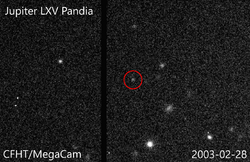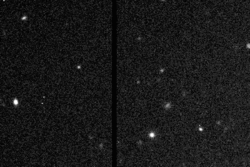Astronomy:Pandia (moon)
 Precovery image of Pandia taken by the Canada-France-Hawaii Telescope in February 2003 | |
| Discovery[1][2] | |
|---|---|
| Discovered by | Scott S. Sheppard |
| Discovery site | Cerro Tololo Obs. |
| Discovery date | 23 March 2017 |
| Designations | |
Designation | Jupiter LXV |
| Pronunciation | /pænˈdaɪə/[3] |
| Named after | Πανδία Pandīa |
| S/2017 J 4 | |
| Orbital characteristics | |
| Epoch 1 January 2000 (JD 2451545.0) | |
| Satellite of | Jupiter |
| Group | Himalia group |
| Proper orbital elements[4] | |
| Proper semi-major axis | 11,481,000 km (0.07675 astronomical unit|AU) AU |
| Proper eccentricity | 0.179 |
| Proper inclination | 29.0° (to ecliptic) |
| Proper mean motion | 521.969928 deg / yr |
Proper Orbital period | 0.68969 yr (251.911 d) |
| Precession of perihelion | 9201.409 arcsec / yr |
| Precession of the ascending node | 4451.925 arcsec / yr |
| Physical characteristics | |
| Mean diameter | ≈3 km[5] |
| Albedo | 0.04 (assumed)[5] |
| Apparent magnitude | 23.0[5] |
| Absolute magnitude (H) | 16.2[1] |
Pandia /pænˈdaɪə/, also designated Jupiter LXV, is a small outer natural satellite of Jupiter discovered by Scott S. Sheppard on 11 May 2018, using the 4.0-meter Víctor M. Blanco Telescope at Cerro Tololo Observatory, Chile . It was announced alongside nine other Jovian moons on 17 July 2018 and it provisionally designated S/2017 J 4 by the Minor Planet Center, after observations were collected over a long enough time span to confirm the satellite's orbit.[1] The satellite has been found in precovery observations as early as 2003.[citation needed]
Pandia is part of the Himalia group, a tight cluster of prograde irregular moons of Jupiter that follow similar orbits to Himalia at semi-major axes between 11–12 million km (6.8–7.5 million mi) and inclinations between 26–31°.[5] With an estimated diameter of 3 km (1.9 mi) for an absolute magnitude of 16.2, it is one of the smallest known members of the Himalia group.[5]
Discovery
Pandia was discovered by Scott S. Sheppard and his team on 23 March 2017, but not announced until 17 July 2018 via a Minor Planet Electronic Circular from the Minor Planet Center.[1]
Name
The moon was named in 2019 after Pandia (Πανδία Pandīa), the Greek goddess of the full moon, daughter of Zeus and Selene.[6] Pandia was among the most popular suggestions in a naming contest held by the Carnegie Institute on Twitter,[7] with the most significant submission coming from the astronomy club of the Lanivet School in Cornwall, United Kingdom that was submitted on their behalf by user "@emmabray182". They chose Pandia because their school's mascot is a panda and their local village used to supply bamboo for a panda at London Zoo.[8]
It belongs to the prograde Himalia group which are given names ending in a.
Orbit
On average, Pandia orbits Jupiter at a semi-major axis of about 11,481,000 km (7,134,000 mi) at an inclination of about 29.0° with respect to the ecliptic. Like all of Jupiter's irregular moons, Pandia orbits far enough away that it is highly subject to gravitational perturbations by the Sun and other planets, which makes its orbit highly variable over time.[4]
References
- ↑ 1.0 1.1 1.2 1.3 "MPEC 2018-O12 : S/2017 J 4". Minor Planet Electronic Circulars. Minor Planet Center. 17 July 2018. https://minorplanetcenter.net/mpec/K18/K18O12.html. Retrieved 17 July 2018.
- ↑ "Planetary Satellite Discovery Circumstances". JPL Solar System Dynamics. NASA. https://ssd.jpl.nasa.gov/sats/discovery.html. Retrieved 10 January 2023.
- ↑ Noah Webster (1884) A Practical Dictionary of the English Language
- ↑ 4.0 4.1 "Planetary Satellite Mean Elements". JPL Solar System Dynamics. NASA. https://ssd.jpl.nasa.gov/sats/elem/sep.html. Retrieved 10 January 2023.
- ↑ 5.0 5.1 5.2 5.3 5.4 Sheppard, Scott S.. "Moons of Jupiter". Earth & Planets Laboratory. Carnegie Institution for Science. https://sites.google.com/carnegiescience.edu/sheppard/moons/jupitermoons. Retrieved 18 July 2018.
- ↑ "Planetary Names: Planet and Satellite Names and Discoverers". https://planetarynames.wr.usgs.gov/Page/Planets.
- ↑ "Naming Contest for Newly-discovered Moons of Jupiter". https://www.iau.org/news/announcements/detail/ann19010/.
- ↑ "Public Contest Successfully Finds Names For Jupiter's New Moons". https://www.iau.org/news/announcements/detail/ann19054/.
 |


